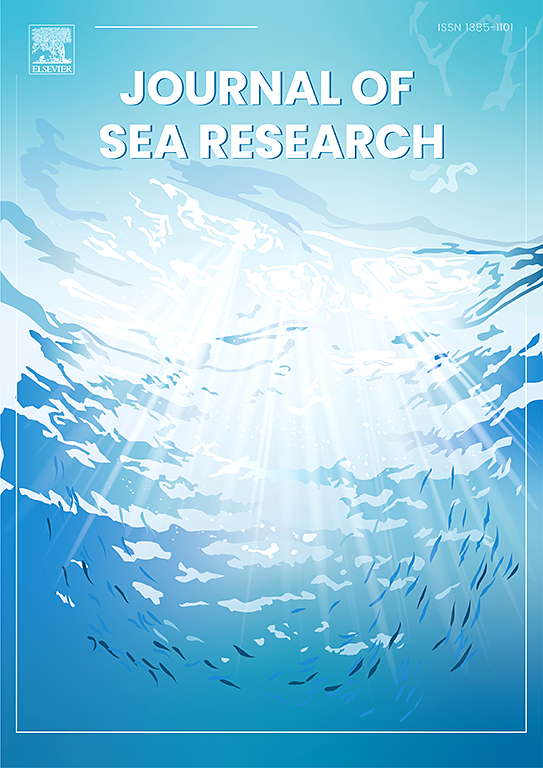The molecularly and visually identified prey of fish in Dutch salt marshes
IF 2.9
4区 地球科学
Q2 MARINE & FRESHWATER BIOLOGY
引用次数: 0
Abstract
Coastal marshes are an important habitat for many juvenile and small fishes, providing refuge and feeding opportunities. Understanding their diets can reveal more about the food web and the underlying factors impacting fish in these threatened habitats. We compared the diets of common goby (Pomatoschistus microps), three-spined stickleback (Gasterosteus aculeatus), Atlantic herring (Clupea harengus), European flounder (Platichthys flesus), European seabass (Dicentrarchus labrax), and European smelt (Osmerus eperlanus). These fish were collected seasonally from Dutch Wadden Sea salt marshes using fyke nets set at fixed stations from three locations with varying degrees of habitat modification. Comparing visual identification and DNA metabarcoding (CO1 region) of stomach contents revealed that DNA (relative read abundance) could be used semi-quantitatively for the dominant prey classes, but failed to detect some prey groups identified visually. The dominant prey of most fish species were the harpacticoid copepod Tachidius discipes, the amphipod Corophium volutator, and other crustaceans including Crangon crangon and Neomysis integer. Diets were affected by season, abiotic conditions, predator length, sampling location, and predator species. Gobies and stickleback shared similar diets, while the four other species displayed distinct diets. Flounder diets were characterised by benthic prey, herring diets consisted predominantly of copepods, smelt were generalists, while seabass diets predominantly contained Malacostraca. Fish diets at the least modified sampling location exhibited the greatest prey diversity. Our findings indicate that salt marshes provide a feeding habitat for the resident and migrant fish species studied, where the degree of marsh habitat modification may affect the marine food web.
荷兰盐沼中鱼类的分子和视觉识别猎物
沿海沼泽是许多幼鱼和小鱼的重要栖息地,为它们提供了避难所和觅食的机会。了解它们的饮食可以揭示更多关于食物网和影响这些受威胁栖息地鱼类的潜在因素。我们比较了普通虾虎鱼(Pomatoschistus microps)、三棘棘鱼(Gasterosteus aculeatus)、大西洋鲱鱼(Clupea harengus)、欧洲比目鱼(Platichthys flesus)、欧洲鲈鱼(Dicentrarchus labrax)和欧洲鲈鱼(Osmerus eperlanus)的饮食。这些鱼是季节性地从荷兰瓦登海的盐沼中收集的,使用的是在三个不同程度栖息地改变的地点的固定站点设置的网。对比胃内容物的视觉识别和DNA元条形码(CO1区)显示,DNA(相对读取丰度)可以半定量地识别优势猎物类别,但无法检测到某些视觉识别的猎物类别。多数鱼类的优势猎物为鳍足类桡足类Tachidius,片足类Corophium volutator,以及其他甲壳类包括Crangon和Neomysis integer。饮食受季节、非生物条件、捕食者长度、采样地点和捕食者种类的影响。虾虎鱼和棘鱼的饮食相似,而其他四种鱼则表现出不同的饮食。比目鱼的饮食以底栖动物为特征,鲱鱼的饮食主要由桡足类组成,鲱鱼是通用的,而鲈鱼的饮食主要包含马拉斯卡鱼。在修改最少的取样位置,鱼的食性表现出最大的猎物多样性。研究结果表明,盐沼为所研究的鱼类提供了一个觅食栖息地,而盐沼栖息地的改变程度可能会影响海洋食物网。
本文章由计算机程序翻译,如有差异,请以英文原文为准。
求助全文
约1分钟内获得全文
求助全文
来源期刊

Journal of Sea Research
地学-海洋学
CiteScore
3.20
自引率
5.00%
发文量
86
审稿时长
6-12 weeks
期刊介绍:
The Journal of Sea Research is an international and multidisciplinary periodical on marine research, with an emphasis on the functioning of marine ecosystems in coastal and shelf seas, including intertidal, estuarine and brackish environments. As several subdisciplines add to this aim, manuscripts are welcome from the fields of marine biology, marine chemistry, marine sedimentology and physical oceanography, provided they add to the understanding of ecosystem processes.
 求助内容:
求助内容: 应助结果提醒方式:
应助结果提醒方式:


